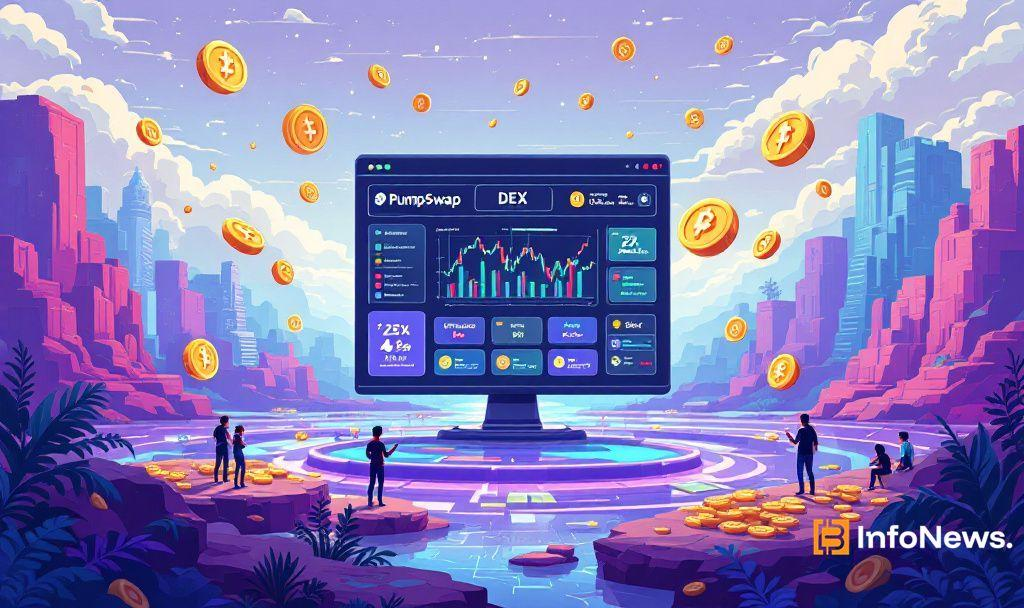Event Background: A Strategic Transformation Amid Revenue Crisis
On March 20, 2025, Pump.fun, a leading meme coin issuance platform in the Solana ecosystem, launched a brand-new decentralized exchange, PumpSwap. The immediate trigger for this launch was a drastic decline in the platform’s revenue—according to DeFiLlama data, as of March 16, Pump.fun’s weekly protocol fee income had fallen to $3.8 million, an 88.6% drop from its November 2024 peak. This downturn was driven by multiple pressures: a regulatory ban by the UK FCA resulting in the loss of European and American users, speculative funds being diverted to BNB and Base chains, and a quality crisis of the platform’s own tokens (with 98.6% of tokens rapidly plummeting to zero after issuance).
The launch of PumpSwap signifies Pump.fun’s transformation from a simple “meme coin launcher” to a full‑ecosystem closed loop. With mechanisms like zero migration fees, instant liquidity migration, and creator revenue sharing, the platform aims to restore user confidence and challenge leading DEXs such as Raydium. For instance, users previously had to pay 6 SOL (approximately $450) to migrate tokens to other exchanges, whereas PumpSwap enables tokens to migrate automatically upon completing a joint curve, avoiding liquidity fragmentation and price volatility risks.

Technical Architecture: Liquidity Integration and Revenue Sharing Innovation
PumpSwap’s core design centers on liquidity efficiency and incentive mechanisms. It adopts a constant product AMM model similar to Uniswap v2, supporting both Solana-native tokens and cross-chain assets (e.g., Aptos tokens). A fee of 0.25% is charged on every transaction, of which 0.20% is allocated to liquidity providers and the remaining 0.05% is retained by the protocol. Future plans include introducing revenue sharing for creators, allowing project teams to earn continuous income from token trades.
Additionally, PumpSwap’s technical optimizations address previous migration process pain points. Once tokens complete the joint curve, the liquidity pool is automatically deployed on PumpSwap without manual intervention or high fees. The platform has also undergone nine independent security audits to ensure code reliability and plans to open-source its smart contracts to enhance transparency. These improvements significantly lower the participation threshold—for example, on its first day, over 5,000 tokens were migrated, and the trading volume exceeded $120 million.
Market Impact: Restructuring the Solana Ecosystem
The launch of PumpSwap directly disrupts the liquidity allocation within the Solana ecosystem. Previously, Raydium handled the vast majority of token migrations from Pump.fun, accounting for 56% of Solana DEX trading volume. In response, Raydium has been forced to accelerate the development of a competing platform, LaunchLab, in a bid to reclaim the meme coin issuance market. This contest may lead to further fragmentation of liquidity within the Solana ecosystem, forcing developers to choose sides among different platforms.
On the other hand, PumpSwap’s cross-chain compatibility opens up new possibilities for ecosystem expansion. By partnering with Tron to introduce cross-chain assets such as APT, the platform aims to replicate the Solana meme coin model on other public chains. This strategy echoes JuCoin’s vision of multi-chain interoperability, though technical risks such as oracle delays remain—indeed, a testnet incident in January 2025, caused by data synchronization issues, revealed vulnerabilities in off‑chain data dependencies.
Challenges and Future Outlook
Despite strong short‑term metrics, PumpSwap still faces multiple challenges.
- Regulatory: The US SEC is investigating whether it involves unregistered securities trading; if found in violation, the platform may be forced to restrict services in certain regions.
- Technical: The 98.6% token failure rate remains unaddressed, casting doubt on the efficacy of the revenue sharing mechanism. Additionally, continuous diversion of speculative funds to the BNB and Base chains raises questions over the sustained momentum of meme coins within the Solana ecosystem.
In the long run, the success of Pump.fun’s strategy will depend on its ability to tackle regulatory pressures through compliance enhancements (such as integrating KYC modules) and to expand the utility of its tokens—potentially by introducing NFT staking or integrating with blockchain gaming. If PumpSwap can balance speculative and practical demands, it may become a benchmark case of “liquidity as a service” in the DeFi 3.0 era, redefining the value proposition of meme coins.
PumpSwap’s launch is not just a technical upgrade—it is a crucial battle in reshaping the power structure within the Solana ecosystem. As the competition for liquidity extends from inter‑chain dynamics to within the ecosystem itself, the landscape of decentralized finance is entering deep waters.




